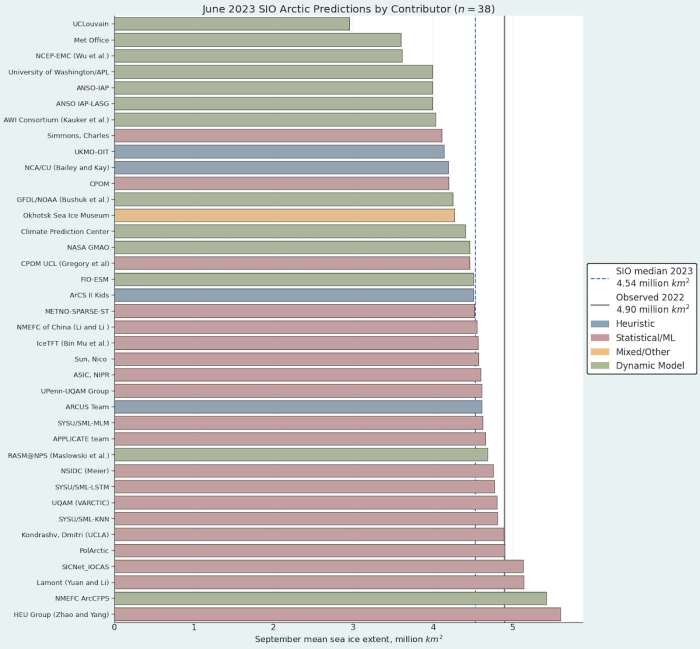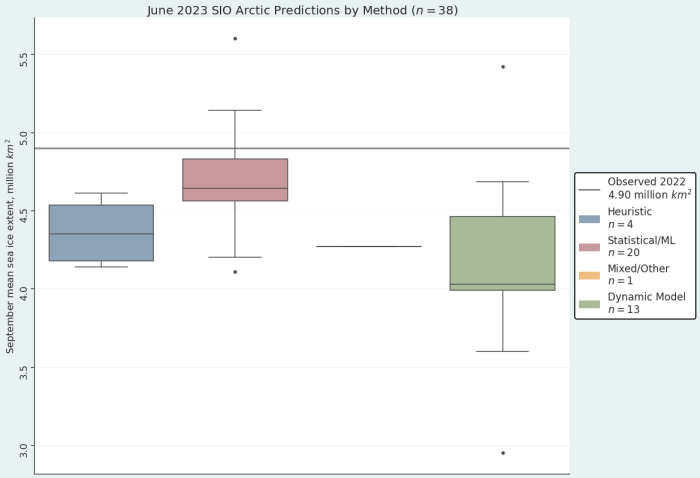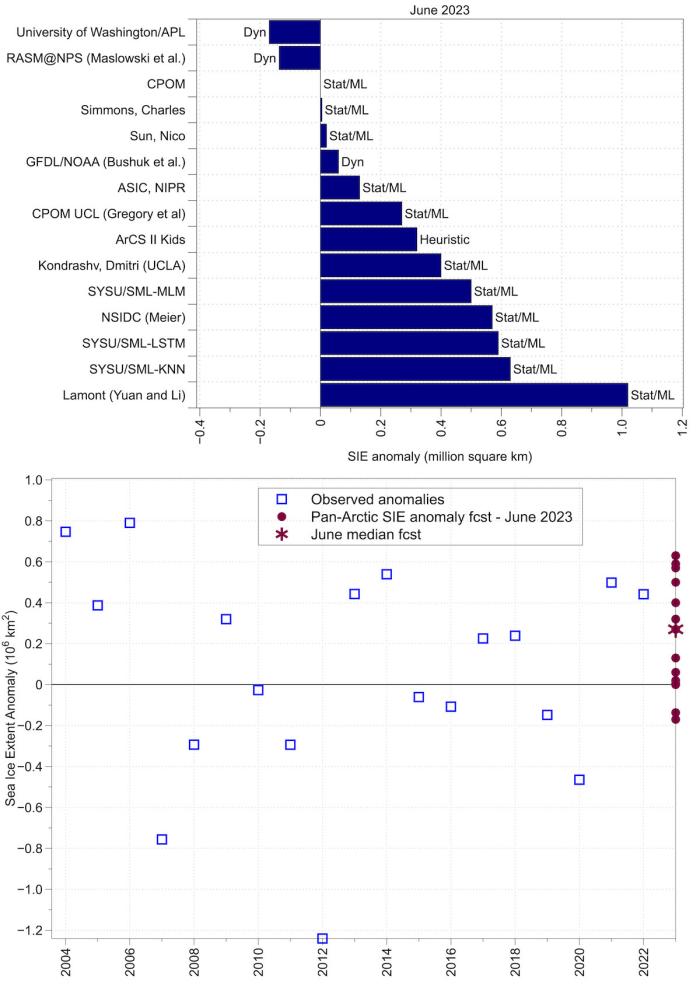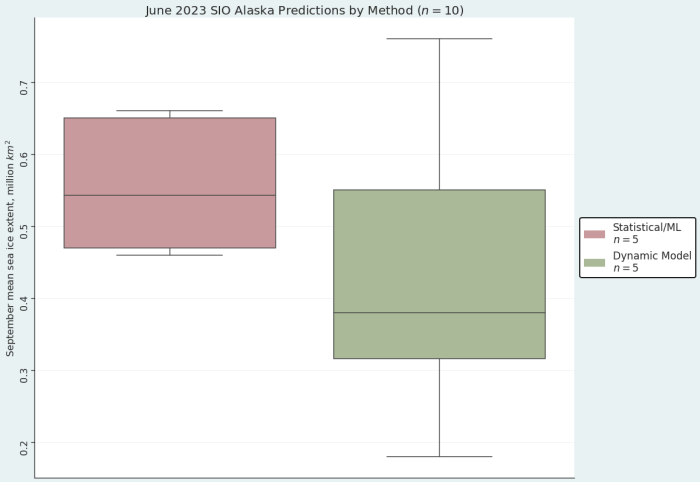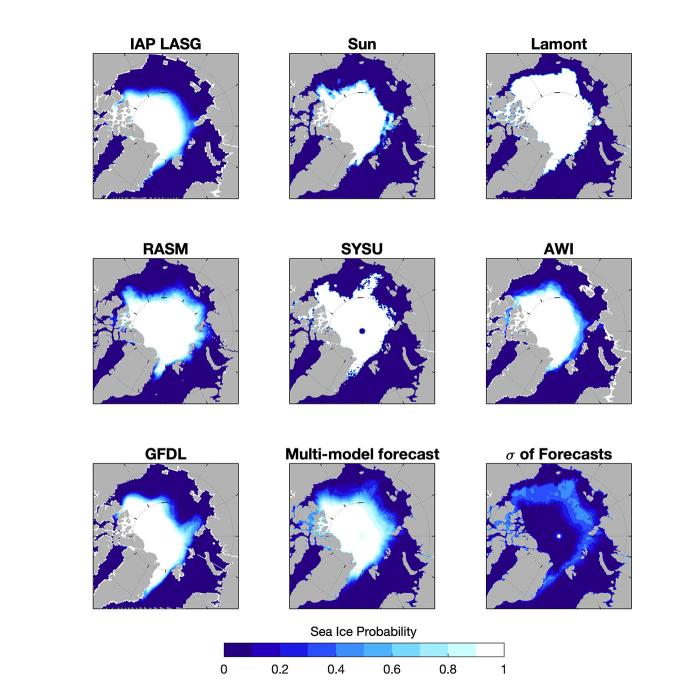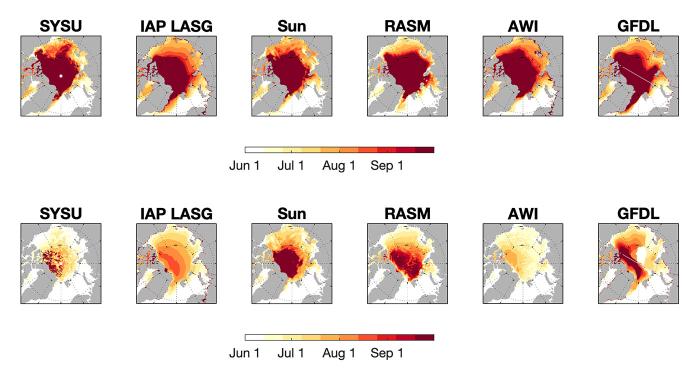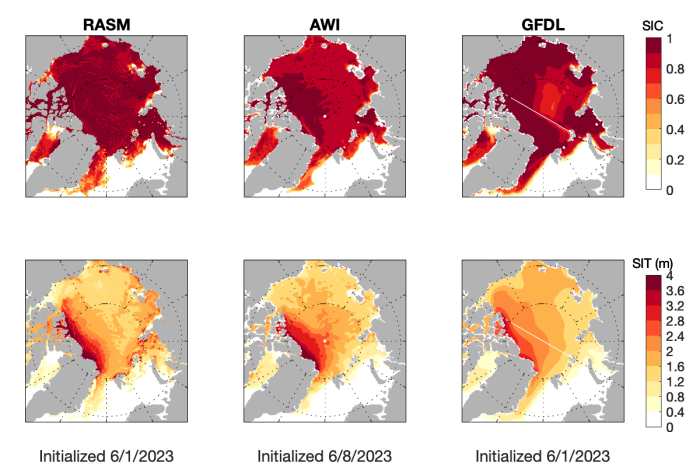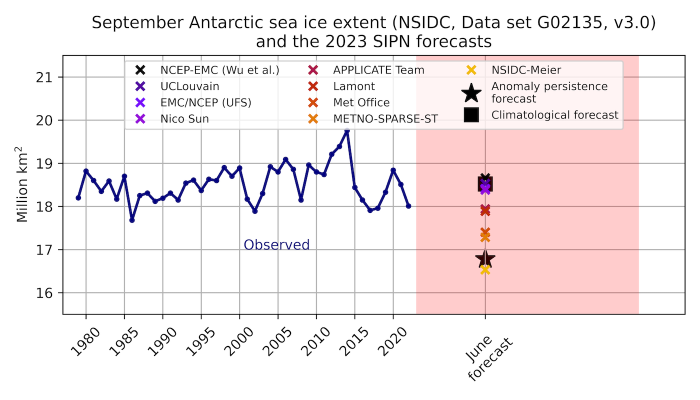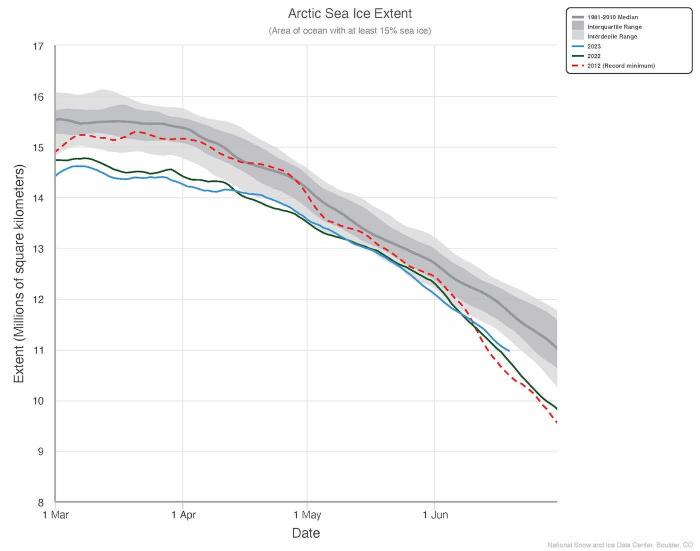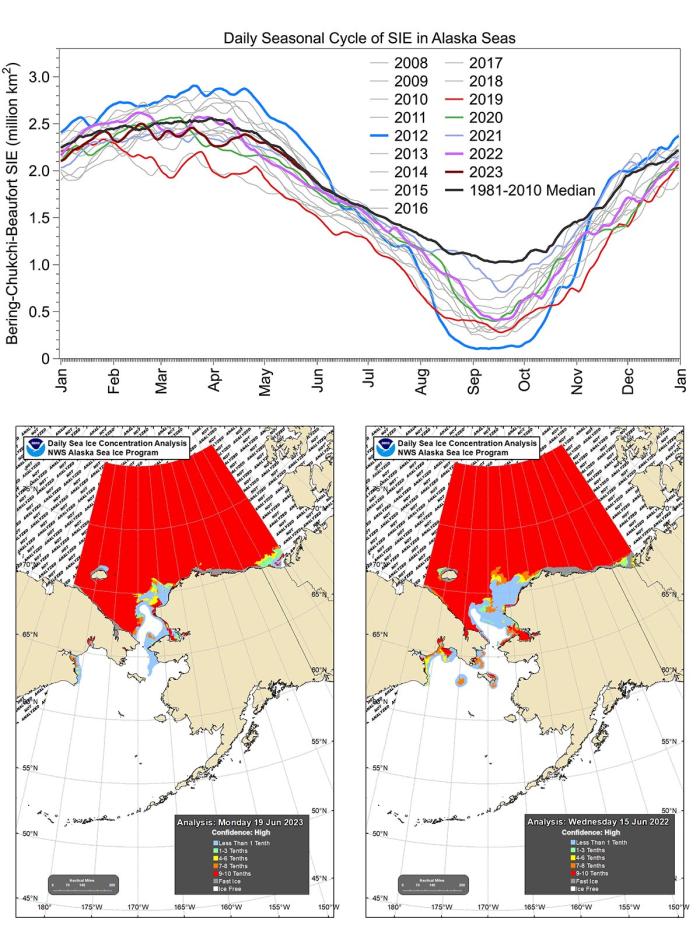Outlook Report
Executive Summary
We thank all the groups and individuals who submitted Outlooks in this 16th year of the Sea Ice Outlook. We also thank NSF for supporting this year's Outlook with funds from NSF award #1331083.
We received 38 contributions of September sea-ice extent that included pan-Arctic forecasts; of these, ten included predictions for the Alaska region (Bering, Chukchi, and Beaufort seas) and nine included predictions for pan-Antarctic. This year's median forecasted value for pan-Arctic September sea-ice extent is 4.54 million square kilometers with an interquartile range of 4.34 to 4.90 million square kilometers. This is nearly the same as last year's June median forecast for September, but higher than the three previous years (2019–2021). The lowest sea-ice extent forecast is 2.95 million square kilometers, which would be a new record low for the satellite period (1979-present), and the highest sea-ice extent forecast is 5.60 million square kilometers. The full contributions, including key statements and summary of uncertainties, are available as PDFs in the "Contributor Full Report PDFs and Supplemental Materials" section below.
The ten Alaska regional sea-ice extent forecasts have a median of 0.51 million square kilometers with an interquartile range of 0.40 to 0.63 million square kilometers. To place these in historical perspective, the September median sea-ice extent for the averaged Alaska seas (Bering, Chukchi, and Beaufort) over 2007–2021 was 0.40 million square kilometers.
For Antarctic sea ice, the median value of forecasted September Antarctic sea-ice extent is 17.92 million square kilometers, with an interquartile range of 17.37 to 18.42 million square kilometers. It is thus expected that September sea-ice extent will be below the climatological average of 18.49 million square kilometers (based on the NASA Team algorithm, distributed through the NSIDC Sea Ice Index).
Seven groups submitted September Arctic mean sea-ice extent anomalies. These seven forecasts range from -0.17 to +1.02 million square kilometers, suggesting that the 2023 September Arctic extent will likely be above the long-term trend line.
Twelve groups submitted supplemental materials (see: Contributor Full Reports and Supplemental Materials below). The supplemental material contents vary among the contributions, but they may include additional figures and information on methodology including (1) how the forecasts are produced; (2) number of ensemble members used in the forecasts; (3) whether and how bias-corrections are applied; (4) ensemble spread, range of forecasts, uncertainties and other statistics; and (5) whether or not post-processing was performed.
This June Outlook Report was developed by lead author Walt Meier, National Snow and Ice Data Center (Executive Summary, Overview of pan-Arctic forecasts, and discussion of current Arctic conditions); with contributions from Uma Bhatt, University of Alaska Fairbanks (Overview of Alaska regional forecasts, discussion of pan-Arctic anomaly sea-ice forecasts and ice conditions in the Bering and Chukchi seas); Edward Blanchard-Wrigglesworth, University of Washington (Discussion of predictions from spatial fields); François Massonnet, Université catholique de Louvain (Discussion of Antarctic contributions); and with input from Mitch Bushuk, NOAA's Geophysical Fluid Dynamics Laboratory; Michael Steele, University of Washington, Applied Physics Laboratory; Matthew Fisher and the NSIDC Development Team, (statistics and graphs); Betsy Turner-Bogren and Helen Wiggins, ARCUS (report coordination and editing).
Note: The Sea Ice Outlook provides an open process for those who are interested in Arctic sea ice to share predictions and ideas; the Outlook is not an operational forecast.
See: June Call for Contributions
2023 SIO Forecasts (Pan-Arctic, Alaska Region, Spatial Forecasts, and Antarctic)
Pan-Arctic Sea-Ice Forecasts
The June 2023 Outlook received 38 pan-Arctic contributions (Figure 1). This year's median forecasted value for pan-Arctic September sea-ice extent is 4.54 million square kilometers with an interquartile ranges of 4.34 to 4.90 million square kilometers. This is nearly the same as last year's June median forecast for September, but higher than the three previous years (2019–2021). The lowest sea-ice extent forecast is 2.95 million square kilometers, from UC Louvain, which would be a new record low for the satellite period (1979-present); the highest sea-ice extent forecast is 5.60 million square kilometers, from the HEU Group, which would be the highest September extent since 2006. Only one Outlook forecasts a new record minimum September extent, though two others (Met Office, NCEP-EMC) forecast an extent that is essentially the same as the record low September (3.57 million square kilometers). The observed extent values are from the NSIDC Sea Ice Index (Fetterer et al., 2017), based on the NASA Team algorithm sea ice concentration fields distributed by the NASA Snow and Ice Distributed Active Archive Center (DAAC) at NSIDC (DiGirolamo et al., 2022; Meier et al., 2021).
There are 13 dynamical model contributions. The models have a median forecast of 4.03 million square kilometers with an interquartile range of 3.99 to 4.46 million square kilometers (Figure 2). The range of the higher quartile is much larger than the lower quartile due to multiple submissions with a forecast of 3.99 million square kilometers. There are four heuristic Outlooks, with a median of 4.35 million square kilometers and an interquartile range of 4.18 to 4.54 million square kilometers. Statistical submissions total twenty Outlooks with a median of 4.64 million square kilometers and an interquartile range of 4.58 to 4.83 million square kilometers. There is one mixed/other method, from the Okhotsk Sea Ice Museum, with a forecast of 4.27 million square kilometers.
The Outlooks from all methods have medians and interquartile ranges below last year's observed September extent, with only the highest statistical methods yielding an extent higher than last year (Figure 2).
Pan-Arctic Sea-Ice Extent Anomalies
This is the third year that the SIO has solicited forecasts of September mean sea-ice extent anomalies. The pan-Arctic anomaly is the departure of the contributors' September extent Outlook relative to their adopted baseline trend (e.g., the trend in historical observations, model hindcasts, etc.). This is motivated by the prospect of reducing SIO extent forecast uncertainty that may originate from models having different trends, mean states, and post-processing methodologies. The 15 anomaly forecasts range from -0.17 to +1.02 million square kilometers, with 12 above and three at or below the contributors' baseline (Figure 3 top). The observed anomalies range from -1.24 (2012) to 0.79 (2006) million square kilometers (Figure 3 bottom). The pan-Arctic 2023 June SIO anomaly forecast has a median of 0.27 and an interquartile range of 0.01 to 0.54 million square kilometers.
Alaska Regional Forecasts
The multimodal median for the June 2023 SIO forecast for the Alaska seas is 0.51 million square kilometers, and a range from a minimum of 0.18 to a maximum of 0.76 million square kilometers (Figure 4). The dynamical model forecasts range from a minimum of 0.18 to a maximum 0.76 million square kilometers with a median of 0.38 million square kilometers. The statistical model forecasts range from a minimum of 0.46 to a maximum of 0.66 million square kilometers with a median of 0.54 million square kilometers. The statistical forecasts display a smaller spread (interquartile range of 0.19) compared to the dynamical models (standard deviation of 0.23) (Figure 5). To place these in historical perspective, the September median sea-ice extent for the Alaska seas (Bering, Chukchi, and Beaufort) over 2007–2022 is 0.44 million square kilometers, making the forecast for 2023 slightly above all median observed values (see Figure 3 of 2022 Postseason SIO report).
Pan-Arctic Forecasts with Spatial Methods
This year we received seven forecasts of September sea ice probability (SIP, the fraction of ensemble members that project September ice concentration in excess of 15%).
Forecasts tend to predict open ocean conditions in the Laptev sea, but this is also the region with the highest forecast uncertainty. The Northeast passage is expected to have low September SIP. There is also some uncertainty on whether the East Siberian 'tongue' of September sea ice will be present this summer, with only SYSU, Lamont, and to a lesser extent Sun forecasting September sea ice in this region.
We have also received 6 forecasts of ice-free date (the first date at which the sea ice concentration drops below a certain threshold, here we use 15% - IFD15 -, and 80% - IFD80).
We have also received three different initial conditions (ICs) from forecasts. While all three thickness ICs have thicker ice north of Greenland and the CAA, there are differences elsewhere. For example, GFDL has fairly thin ICs in the Laptev, but thicker in the East Siberian Sea, whereas RASM has fairly thick ICs in the Laptev Sea and thin in the East Siberian Sea. It is interesting to note the low SIP forecasts in the Laptev Sea in GFDL in Figure 6, but higher SIP forecasts in the Laptev Sea in RASM.
Antarctic Forecasts
We received Antarctic submissions from nine groups. As for previous Outlooks, a large spread exists in the forecast: the range (min-max) is the same order of magnitude as the range in the observational record. An interesting feature is that almost all submissions predict a September mean sea ice extent that will be below the 1979-2022 climatological average. This is in line with the recent summer predictions that were conducted in the context of the SIPN South project (Massonnet et al., 2023). Notably, the anomaly persistence forecast constructed by adding the May sea ice extent anomaly to the September sea ice extent average, predicts a record low. This is not surprising given that, after the 2023 record low in February, Antarctic sea ice extent has been tracking well below the climatological average.
Current Conditions
Pan-Arctic Conditions
Sea ice conditions have been fairly unremarkable through the spring. Total Arctic extent has been lower than the 1981 to 2010 median and below the lower interdecile range except for a period during May when extent tracked along the lower interdecile range value (Figure 10). Through May, extent also remained below the spring extent in 2012, the year with the record low September extent in the satellite era (since 1979). However, toward the middle of June (after the June Outlooks were submitted), the 2012 extent accelerated and as of mid-June, the 2023 extent is tracking above the 2012 extent.
Note: Figure 10 is from NSIDC Charctic, based on data from (NSIDC Sea Ice Index, Fetterer et al., 2017) and the NASA Team sea ice concentration product at NSIDC (DiGirolamo et al., 2022; Meier et al., 2021).
The primary area of low extent has been the Barents Sea (Figure 11). Hudson Bay has also begun to open early and ice-free areas have opened up along the coast and fast ice regions in the Siberian seas. Elsewhere, the extent is near-normal for this time of year.
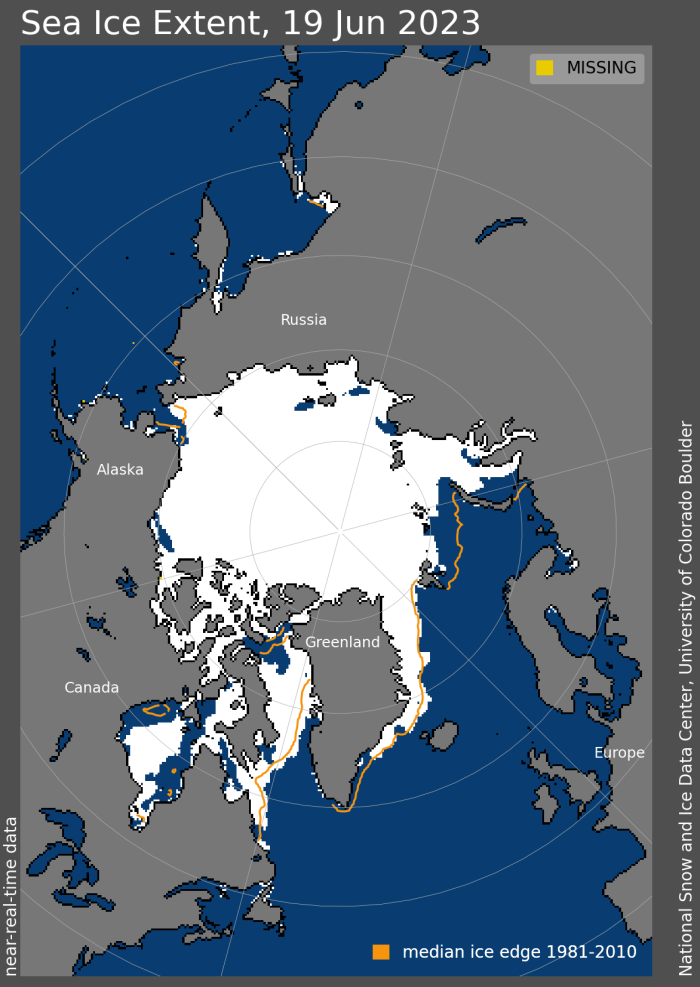
Note: Figure 11 is from NSIDC Arctic Sea Ice News and Analysis, based on (NSIDC Sea Ice Index, Fetterer et al., 2017) and the NASA Team sea ice concentration product at NSIDC (DiGirolamo et al., 2022; Meier et al., 2021).
Atmospheric conditions during spring in the Arctic were fairly moderate over the Arctic Ocean. The primary feature of note was cooler conditions in the Laptev Sea and to the northwest toward the pole, where temperatures were upwards of 4 degrees C below average (Figure 12). Temperatures were up to 4 degrees C above average in parts of the Canadian Archipelago, Hudson Bay, and Baffin Bay. Temperatures were 1 to 2 degrees C above normal in the Barents and Kara Seas. Elsewhere, temperatures were near normal.
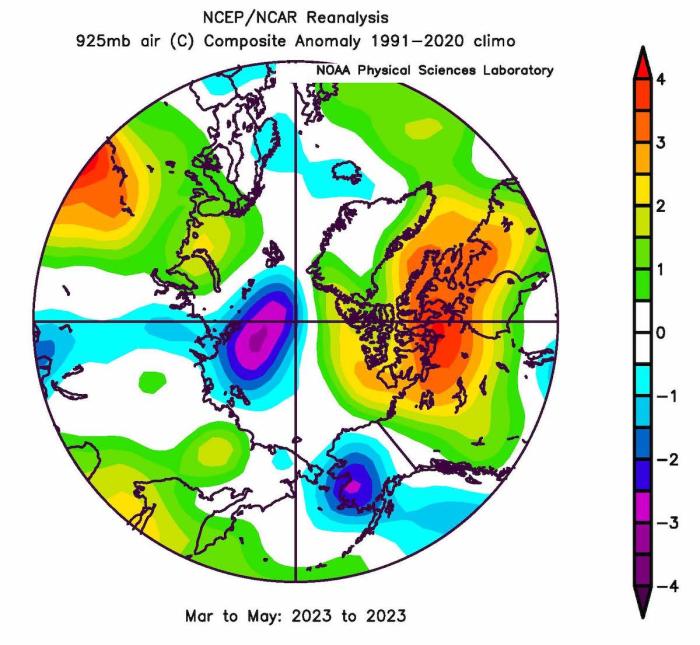
Note: Figure 12 image is provided by the NOAA Physical Sciences Laboratory, Boulder Colorado (Kalnay et al., 1996).
Sea level pressure for March to May 2023 was generally low over much of the Arctic, particularly over the Kara and Barents Sea (Figure 13). The low pressure may have led to cloudier than average skies, resulting in the lower than average temperatures in the Laptev Sea sector. On the other hand, the circulation around the low may have brought in warmer air from the south in the Barents and Kara Seas, leading to the above average temperatures there. There was high pressure over the Canadian Archipelago, which tends to yield sunnier conditions and thus the warmer temperatures seen in the region.
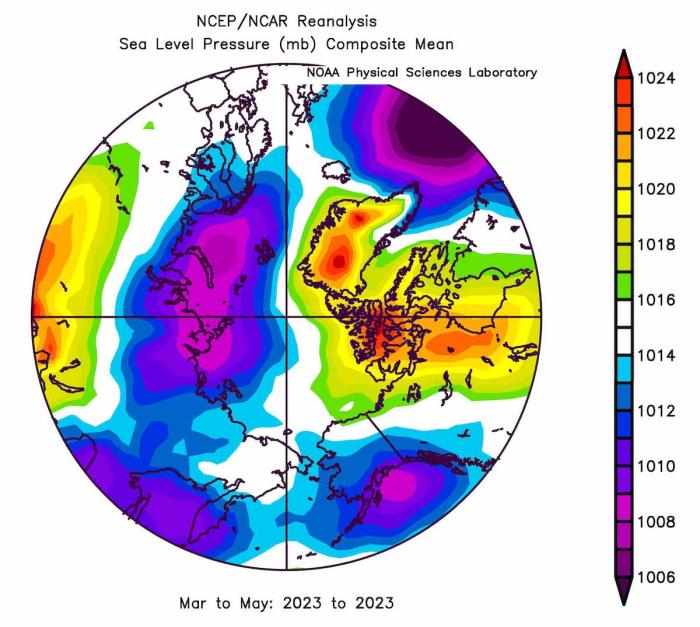
Note: Figure 13 image is provided by the NOAA Physical Sciences Laboratory, Boulder Colorado (Kalnay et al., 1996).
Alaska Regional Conditions
The seasonal cycle of daily sea ice in the Alaska seas in 2023 remained just below climatology until May and subsequently has followed climatology (1981-2010 median) (Figure 10, top). Sea ice is slightly more extensive in the Chukchi Sea compared to a year ago (Figure 10, bottom).
References
DiGirolamo, N., C. L. Parkinson, D. J. Cavalieri, P. Gloersen, and H. J. Zwally. (2022). Sea Ice Concentrations from Nimbus-7 SMMR and DMSP SSM/I-SSMIS Passive Microwave Data, Version 2 [Data Set]. Boulder, Colorado USA. NASA National Snow and Ice Data Center Distributed Active Archive Center. https://doi.org/10.5067/MPYG15WAA4WX. Date Accessed 06-20-2023.
Fetterer, F., K. Knowles, W. N. Meier, M. Savoie, and A. K. Windnagel. (2017). Sea Ice Index, Version 3 [Data Set]. Boulder, Colorado USA. National Snow and Ice Data Center. https://doi.org/10.7265/N5K072F8. Date Accessed 06-20-2023.
Kalnay et al.,The NCEP/NCAR 40-year reanalysis project, Bull. Amer. Meteor. Soc., 77, 437-470, 1996.
Massonnet, F., Barreira, S., Barthélemy, A., Bilbao, R., Blanchard-Wrigglesworth, E., Blockley, E., Bromwich, D. H., Bushuk, M., Dong, X., Goessling, H. F., Hobbs, W., Iovino, D., Lee, W.-S., Li, C., Meier, W. N., Merryfield, W. J., Moreno-Chamarro, E., Morioka, Y., Li, X., … Yuan, X. (2023). SIPN South: Six years of coordinated seasonal Antarctic sea ice predictions. Frontiers in Marine Science, 10. https://www.frontiersin.org/articles/10.3389/fmars.2023.1148899
Meier, W. N., J. S. Stewart, H. Wilcox, M. A. Hardman, and D. J. Scott. (2021). Near-Real-Time DMSP SSMIS Daily Polar Gridded Sea Ice Concentrations, Version 2 [Data Set]. Boulder, Colorado USA. NASA National Snow and Ice Data Center Distributed Active Archive Center. https://doi.org/10.5067/YTTHO2FJQ97K. Date Accessed 06-20-2023.
Contributor Full Report PDFs and Supplemental Materials
Pan-Arctic Individual PDFs
This report was developed by Sea Ice Prediction Network (SIPN) team members.
Report Lead:
Walt Meier, National Snow and Ice Data Center (NSIDC), Cooperative Institute for Research in Environmental Sciences (CIRES) at the University of Colorado, Boulder.
Additional Contributors:
- Uma Bhatt, University of Alaska Fairbanks, Dept. of Atmospheric Sciences, Geophysical Institute, International Arctic Research Center
- Edward Blanchard-Wrigglesworth, University of Washington, Department of Atmospheric Sciences
- Mitch Bushuk, NOAA's Geophysical Fluid Dynamics Laboratory
- François Massonnet, Université Catholique de Louvain (Belgium)
- Michael Steel, University of Washington, Applied Physics Laboratory
- Helen Wiggins, Arctic Research Consortium of the U.S. (ARCUS), Executive Director
- Matthew Fisher and the NSIDC Development Team, NSIDC, Cooperative Institute for Research in Environmental Sciences at the University of Colorado Boulder
Editors:
Betsy Turner-Bogren, (ARCUS)
Helen Wiggins, (ARCUS)
Suggested Citation:
Meier, W., U.S. Bhatt, E. Blanchard-Wrigglesworth, M. Bushuk, M. Fisher, F. Massonnet, M. Steele, and H. V. Wiggins. Editors: Turner-Bogren, B. and H. V. Wiggins. June 2023. "Sea Ice Outlook: 2023 June Report." (Published online at: https://www.arcus.org/sipn/sea-ice-outlook/2023/june)
This Sea Ice Outlook Report is supported in part by with funds from NSF award #1331083. Any opinions, findings, and conclusions or recommendations expressed in this material are those of the author(s) and do not necessarily reflect the views of the National Science Foundation.


